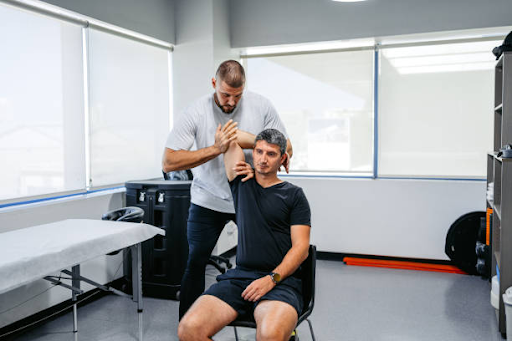What are the Differences Between Physiotherapist and Chiropractor?
When it comes to managing pain, recovering from injuries, or optimizing overall health, many people turn to professionals like chiropractors and physiotherapists. While both of these healthcare providers play crucial roles in enhancing physical well-being, they have distinct approaches and philosophies. Understanding the nuances of physiotherapist vs chiropractor can help you choose the right professional for your specific needs. Let’s find out more about chiropractors vs physiotherapists, what they do, and how integrating their services can benefit your health.
Who is a Chiropractor?
A chiropractor is a licensed professional who follows a hands-on approach to treating pain and inflammation. It puts a special focus on the musculoskeletal and nervous systems to let your body heal itself with the best chiropractic care. A professional chiropractor evaluates your symptoms, provides adjustments based on your condition, and recommends some exercises that you can do at home or lifestyle adjustments to reduce the pain levels.
Who is a Physiotherapist?
Also called a PT, a physiotherapist focuses mainly on improving the mobility and function of the body without pain, further leading to enhancing your quality of life. If your movement is restricted due to an accident, injury, surgery, or any underlying health condition, you must go to a professional physiotherapist to combat its effects and build strength.
What are the key Differences Between Chiropractor Vs Physiotherapist?

There are some vital differences between a chiropractor vs physiotherapist. Those are –
Definition
Physiotherapy is primarily concerned with improving your life through using a combination of preventive measures and rehabilitative care. Techniques of physiotherapy can treat several problems, focusing on geriatric, vestibular, pediatric, perinatal, post-surgery, neurological, cardiovascular, and respiratory issues.
On the opposite side, a chiropractor uses a non-invasive and drug-free approach to work on your musculoskeletal system, mainly the spine. When an individual is diagnosed with a specific condition, a chiropractor uses a bundle of techniques for applying pressure to the affected areas to get rid of tension and stiffness.
Education and training
Any person who wants to be a physiotherapist requires a bachelor’s degre in physiotherapy. The major focuse of this course is on physiotherapy orientation, clinical training, exercise therapy, allied therapies, and other physiology-related subjects. Also, after completing your degree, gain hands-on experience by working in gyms, hospitals, or care centers.
On the other hand, the education and training of a chiropractor is more intense. In addition to the bachelor’s, experts advise you to pursue a master’s. During the period when you are studying, you gain training in microbiology, physiology, pathology, public health, and biochemistry. When you are in the final years of the course, you get a specialization in spinal adjustments and practical experience. These specializations and experiences help you in the assessment and diagnosis of specific geriatric, orthopedic, and neurological issues.
Treatment and approaches
The next in the list of physiotherapy vs chiropractic care is on the basis of treatment and approaches. Physio works on 3 main approaches that are education and advice, movement and exercise, and manual therapy. The first step is education and advice, which involves assessing the full body rather than only an affected area. Based on this assessment, a physiotherapist gives you tips that you can incorporate into your lifestyle. The next is movement and exercise, where the physiotherapist will recommend that you follow a range of techniques to experience improvement in mobility. The exercise could include a combination of stretching, strengthening, and hydrotherapy to heal your affected area. Ultimately, manual therapy means that a PT uses a hands-on technique to release tension and pain from your muscles.
While, a chiropractor focuses mainly on the techniques used to manipulate the musculoskeletal system. 6 common techniques are used in chiropractic care. The first one is the Flexion distraction for improving spinal motion and fixing misaligned discs. Next is the Gonstead technique to adjust your lower back and pelvis. The third method is the activator method, in which specialized instruments are used to apply a low-force pulse to the affected area. Extremity manipulation, which is the 4th method, helps readjust the joints outside of the spine, which includes the hip, shoulder, knee, and wrist joints. Another method is the mobilization technique, which uses gentle pressure and stretches the joints to enhance the mobility quotient. The last on the list is the drop technique or Thompson technique. It is a system of analysis that checks leg length to determine where the spine misalignments exist.
Conditions treated
Now comes the conditions treated in physiotherapy vs chiropractic care. In physiotherapy, PT uses stretching, strengthening, electrotherapy, and hydrotherapy techniques to treat various conditions. The list of these conditions are orthopedic (back pain, arthritis, spasms, sciatica, joint problems, ligament tears), neurological (Alzheimer’s disease, cerebral palsy, concussion, multiple sclerosis, vertigo, and stroke), autoimmune conditions like Rheumatoid arthritis, fibromyalgia, chronic conditions (asthma, diabetes, and obesity), perinatal and postnatal (thoracic pain, abdominal separation, upper back pain, urinary incontinence, pelvic pain) and vestibular conditions.
In comparison, chiropractors use specialized instruments to treat different conditions. These are temporomandibular joint problems, which means pain and discomfort in the jaw joints and muscles, neck pain, shoulder pain, scoliosis, hip bursitis, disc pain, and plantar fasciitis. Besides, chiropractic professionals treat posture-related and gait issues.
Integrating chiropractic and physiotherapy for optimal health benefits

There is an overlap in the conditions treated by a physiotherapist vs a chiropractor. For example, both therapies relieve pain and treat musculoskeletal conditions and stiffness. However, treatment styles may vary depending on the origin and discomfort. If you are suffering from neurological conditions, it is advisable to seek treatment from a chiropractor. On the flip side, if the symptoms you are facing are associated with a musculoskeletal condition, go to a physiotherapist.
The best way is to integrate both treatment styles and achieve enhanced recovery, holistic care, and optimal health.
Conclusion
Chiropractors and physiotherapists both play vital roles in promoting physical health, but they do so through different approaches. Understanding the differences between a physiotherapist vs chiropractor can help you make informed decisions about your healthcare needs. Additionally, integrating chiropractic and physiotherapy services can provide a holistic approach to your health.
Whether you’re dealing with pain, recovering from an injury, or simply looking to optimize your physical health, Mankind Rehab Center is there for all your healthcare needs. We have a professional team of chiropractors and physiotherapists, in addition to acupuncturists, laser therapists, reflexology experts, and registered massage therapists. Let our physiotherapy and chiropractic care play a valuable role in your journey to wellness. Contact us to gain more insights.













I just wanted to drop a note how much I appreciated this post!
It’s so refreshing to find detailed and useful information like
this. What you’ve shared is highly relevant, especially today when so many people are dedicating themselves
to their health and well-being. I’ll definitely be referencing this article on my site about massage devices,
as I think my readers will find it just as useful.
Awesome job!